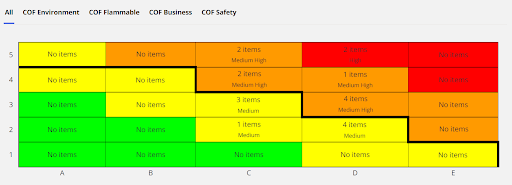“Safety first” is the bread and butter of the industrial sector. But where does safety meet other important factors such as cost-efficiency? To answer this question we dedicate a three-part chapter to introduce the concept of Risk-Based Inspection (RBI). This blog forms an introduction to the methodology where we cover the base principles and our approach.
The first step is understanding risk
Risk-Based Inspection (RBI) is, as the name suggests, a process that enables one to prioritize inspections based on risk associated with individual pieces of equipment or piping. Risk is defined as the following:
risk = POF (probability of failure) x COF (consequence of failure)
This results in a more efficient use of inspection resources and more effective inspections. However, a damage mechanisms review (corrosion study) is an essential basis for RBI.
Potential methodologies for implementing a risk based inspection program are covered in recommended practices and standards such as API 580 and 581.
The process of RBI
The RBI implementation process starts with collecting data and information on the plant assets (e.g. design and construction records as well as inspection and maintenance records), on the operating and process technology, and of course PFDs (process flow diagrams). Based on all this information, our corrosion experts perform a damage mechanisms review using the concept of corrosion loops.
A corrosion loop is defined as part of the process with a similar fluid that is subjected to similar process conditions resulting in similar potential damage mechanisms for a similar material of construction. Not only internal damage mechanisms are listed but also external mechanisms such as atmospheric corrosion, corrosion under insulation (CUI) and so forth.
The RBI implementation process is a team effort between subject matter experts (such as corrosion engineers, process engineers, inspection & maintenance). Important milestones such as the identification of corrosion loops and piping circuits and the finalized credible damage mechanisms per plant asset are important team decisions.
METALogic provides default probability of failure (POF) calculation following API 581 methodology using the concept of damage factors that are based on outcome of the damage mechanism review, inspection and maintenance history and plant asset design. With regard to geometry a minimum allowable wall thickness (MAWT) can be calculated according to a customer specific code or (standard) via API 579.
Although COF is often determined qualitatively in an initial RBI implementation, any COF-model can be implemented in METALogic’s proprietary CorLife™ software. Based on COF and POF the risk is determined and visualized in the risk matrix. Risk matrix layout and POF and COF categories can be modeled according to the customer’s needs.
Example of a default risk matrix from Cor-Life
As the goal of RBI is to mitigate risks, measurements (such as extra inspections) may be needed to decrease the risk level. Based on the projected risk and an acceptable risk target, inspection plans are automatically proposed based on client-specific inspection strategy libraries. The inspection plans are committed to the RBI team for further actions.
Evergreening
Evergreening in the RBI process involves management of inspection reports and inspection results for the purpose of updating the risk profile of the plant and setting new future mitigation strategies. Inspection result management for risk calculation is done using inspection campaigns and inspection campaign rating. A rating is assigned based on the probability of an inspection to detect a certain degradation morphology on the used inspection method and technique and the extent of the inspection.
Evergreening makes sure all information remains updated according to the latest results/insights. A good RBI software is essential to keep all the data easily accessible to feedback new information to the calculation of risk and inspection plans.
So in a nutshell, adopting RBI methodology in a plant offers a way to improve inspection effectiveness which results in a positive outcome when it comes to both cost and safety. If you would like to know more about the software METALogic has developed for damage mechanism reviews and RBI, stay-tuned! Want to know more about our way of working? Contact us for more information





